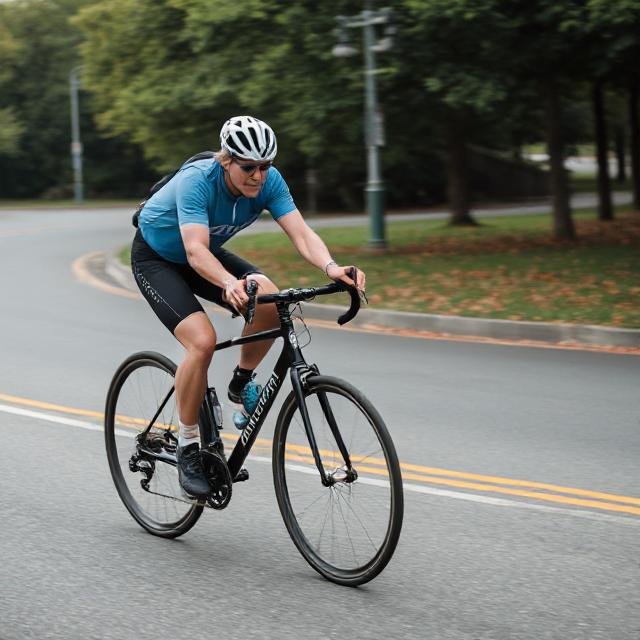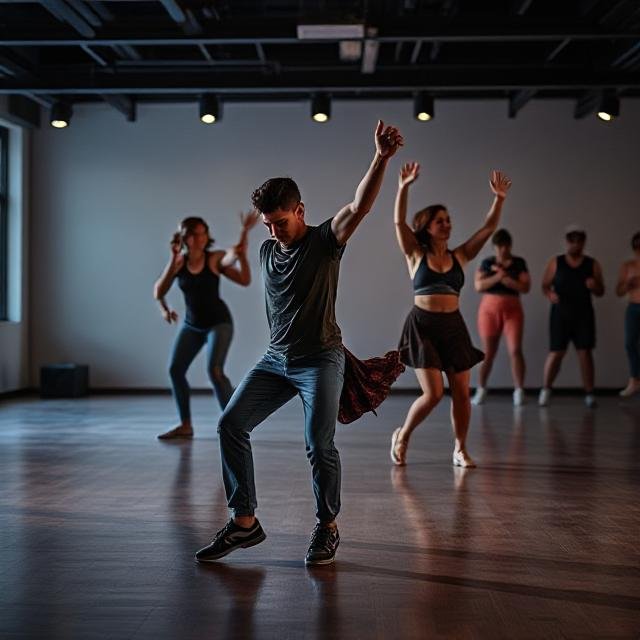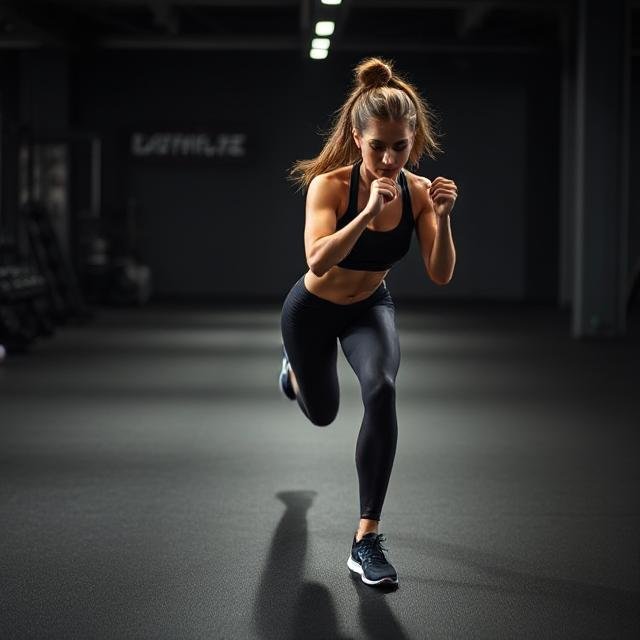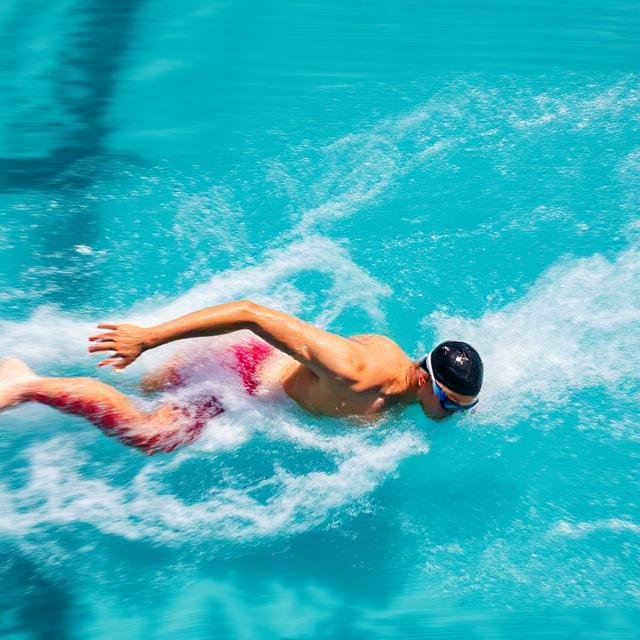Cardio Exercise
(Great for Heart and Endurance)
Cardio exercise—short for cardiovascular exercise—refers to physical activity that raises your heart rate and keeps it elevated for a sustained period. It primarily strengthens the heart and lungs, improving overall cardiovascular health.
Key Benefits:
- Improves heart health and circulation
- Burns calories, aiding in weight loss or maintenance
- Boosts endurance and stamina
- Enhances mood by releasing endorphins
- Lowers risk of chronic diseases like heart disease, diabetes, and high blood pressure
Common Types:
- Running or jogging
- Walking briskly
- Cycling (indoor or outdoor)
- Swimming
- Jump rope
- Rowing
- Dancing
- HIIT (High-Intensity Interval Training)
Guidelines:
Health authorities recommend at least 150 minutes of moderate-intensity or 75 minutes of high-intensity cardio per week for general health.
Running and jogging are powerful forms of cardiovascular exercise that benefit both the body and mind. While jogging is typically done at a slower, more relaxed pace and running at a faster, more intense one, both activities improve heart health, boost lung capacity, and strengthen muscles—especially in the legs and core. Regular practice helps burn calories, promote fat loss, and increase overall endurance. Beyond the physical benefits, running and jogging also support mental well-being by reducing stress, improving mood, and releasing feel-good hormones like endorphins. Whether you’re aiming to stay fit, lose weight, or clear your mind, running and jogging are simple, effective ways to enhance your health and energy.
Here are different ways to run or jog, depending on your goals and preferences:
1. Road Running 🛣️
- Running on sidewalks, pavements, or roads.
- Great for endurance and accessibility.
- Be mindful of traffic and wear proper running shoes.
2. Trail Running 🌿
- Running on dirt paths, hills, and nature trails.
- Engages more muscles due to uneven terrain.
- Requires trail-running shoes for grip and stability.
3. Treadmill Running 🏃♂️
- Running indoors on a treadmill.
- Controlled speed, incline options, and weather-proof.
- Ideal for beginners and interval training.
4. Interval Running (HIIT Running) ⏳
- Alternating between sprinting and walking/jogging.
- Burns more calories and improves speed.
- Example: Sprint 30 seconds, walk 1 minute, repeat.
5. Long-Distance Running (Endurance Running) 🏅
- Running at a steady pace for extended periods (5K, 10K, marathons).
- Builds stamina, cardiovascular health, and mental toughness.
6. Sprinting ⚡
- Running at maximum speed for short distances (100m-400m).
- Great for building explosive power and leg strength.
7. Barefoot Running 🦶
- Running without shoes or with minimalist footwear.
- Strengthens foot muscles but requires gradual adaptation.
8. Uphill Running (Hill Sprints) ⛰️
- Running uphill to build leg strength and endurance.
- Boosts cardiovascular fitness and speed.
9. Beach Running 🏖️
- Running on sand for extra resistance.
- Strengthens lower legs but requires more effort.
10. Group or Social Running 👟
- Running with a club, friends, or group for motivation.
- Helps maintain consistency and accountability.

Jumping rope is a fantastic full-body workout that improves coordination, endurance, and cardiovascular health. Here are different ways to jump rope, ranging from basic to advanced techniques:
Accordion Content
🏆 Basic Jump Rope Techniques
- Basic Jump 🏃♂️
- Jump with both feet together.
- Keep a steady rhythm and maintain a slight bend in the knees.
- Alternate Foot Step (Jogging Step) 👟
- Jump by alternating feet, like jogging in place.
- Reduces impact and increases endurance.
- Side-to-Side Jumps ↔️
- Jump slightly left and right with both feet together.
- Engages core muscles and improves agility.
- Forward and Backward Jumps 🔄
- Jump slightly forward and then backward instead of straight up.
- Great for coordination and calf strength.
🔥 Intermediate Jump Rope Techniques
- High Knees 🚀
- Jump while bringing knees up to waist height.
- Increases heart rate and burns more calories.
- Butt Kicks 🍑
- Kick your heels back towards your glutes with each jump.
- Helps improve hamstring flexibility and endurance.
- Criss-Cross Arms ❌
- Cross your arms in front of you while jumping.
- Enhances hand-eye coordination and arm control.
- Double Side Swings 🔄
- Swing the rope twice to one side before jumping.
- Improves rope control and shoulder endurance.
Advanced Jump Rope Techniques
- Double Unders ⏫
- Swing the rope twice under your feet per jump.
- Requires explosive jumping and fast wrist movement.
- Triple Unders 🔥🔥🔥
- Swing the rope three times under your feet in one jump.
- A highly advanced skill for experienced jumpers.
- Boxer Skip 🥊
- Shift weight from one foot to another like a boxer.
- Reduces fatigue and builds stamina.
- Side Swing & Jump ⏩
- Swing the rope to the side once, then jump over it on the next turn.
- Great for breaking up the routine and improving coordination.
- Backward Jumping 🔙
- Swing the rope backward and jump normally.
- Improves balance and rope control.
- One-Legged Jumps 🦵
- Jump on one foot for a set number of reps, then switch.
- Builds lower body strength and balance.

Cycling is a low-impact aerobic exercise that offers numerous health benefits, making it a popular choice for people of all ages and fitness levels. It strengthens the heart, lungs, and muscles while improving joint mobility and reducing stress levels. Whether done outdoors on scenic trails or indoors on stationary bikes, cycling helps burn calories, build endurance, and enhance mental well-being. It’s also an eco-friendly mode of transportation that contributes to a cleaner environment. With its versatility and accessibility, cycling is an enjoyable and effective way to stay fit and active.
Here are different ways to cycle, depending on your goals and preferences:
🚴♂️ Types of Cycling
1. Road Cycling 🛣️
- Riding on paved roads, highways, or bike lanes.
- Great for long-distance endurance and speed.
- Requires a road bike with thin tires for efficiency.
2. Mountain Biking ⛰️
- Riding on rough terrains like trails, hills, and forests.
- Strengthens legs, core, and balance due to uneven ground.
- Needs a sturdy mountain bike with suspension.
3. Indoor Cycling (Stationary Bike or Spin Classes) 🚲🏠
- Cycling on a stationary bike at home or in a gym.
- Controlled resistance levels for endurance and interval training.
- Ideal for all fitness levels and bad weather conditions.
4. Commuter Cycling 🚦
- Biking to work, school, or daily errands.
- Saves money, is eco-friendly, and boosts daily activity.
- Use a hybrid or commuter bike for comfort.
5. BMX or Trick Cycling 🎭
- Performing stunts, jumps, and tricks on a BMX bike.
- Requires strength, coordination, and skill.
- Done in skate parks, dirt tracks, or urban areas.
6. Gravel Biking 🌾
- Riding on mixed terrain (gravel, dirt, pavement).
- Great for adventure and endurance training.
- Needs a gravel bike with wider tires for stability.
7. Fat Tire Biking ❄️🏜️
- Cycling on snow, sand, or rough terrain.
- Uses extra-wide tires for better grip.
- Perfect for extreme weather conditions.
8. Tandem Cycling 🚴♂️🚴♀️
- Two riders on a single bike, working together.
- Requires teamwork and coordination.
- Fun for couples, friends, or team challenges.
9. Electric Biking (E-Bikes) ⚡
- Uses a battery-powered motor to assist pedaling.
- Ideal for longer rides, hilly areas, and commuting.
- Helps people with joint issues or lower endurance.
10. Cycle Touring (Bikepacking) 🎒
- Long-distance cycling with camping or adventure travel.
- Requires endurance, planning, and carrying supplies.
- Uses touring bikes designed for comfort and durability.
🔥 Bonus Cycling Workouts
🚴 Beginner: 20-30 min steady ride (flat terrain)
🚴♀️ Intermediate: 40 min ride with hills & moderate speed
🚴♂️ Advanced: 1-hour interval ride (Sprint 30 sec, Ride steady 2 min, Repeat 10 times)

Dancing is a fun and energetic way to improve physical fitness while lifting your mood and reducing stress. It combines rhythmic movement with cardiovascular activity, helping to burn calories, build muscle tone, and enhance coordination and balance. From high-intensity styles like Zumba to more fluid forms like contemporary dance or ballet-based workouts, dancing caters to all fitness levels and preferences. It also encourages self-expression, making it a mentally stimulating activity that supports emotional well-being. Whether in a class or at home, dancing turns exercise into an enjoyable and motivating experience.
There are various types of dance styles that focus on different rhythms, techniques, and body movements. Here are some popular ways to dance:
1. Hip-Hop Dance
Description: A high-energy, street-style dance that emerged from urban culture. It includes various movements like popping, locking, and breaking.
- Moves: Popping, locking, breaking, b-boying, and freestyle movements.
- Benefits: Improves coordination, boosts cardiovascular health, and enhances flexibility.
- Style: Energetic, expressive, and rhythmic, often performed to hip-hop or rap music.
2. Ballet
Description: A highly technical form of dance with its own vocabulary. It emphasizes posture, technique, and grace.
- Moves: Pirouettes, arabesques, pliés, and jetés.
- Benefits: Builds flexibility, strength, and posture, improving balance and core stability.
- Style: Graceful, precise, and disciplined, often performed in classical music.
3. Salsa
Description: A Latin dance style known for its fast-paced and lively movements, typically performed in pairs.
- Moves: Quick footwork, turns, spins, and partner coordination.
- Benefits: Improves coordination, cardiovascular health, and promotes social interaction.
- Style: Fun, energetic, and sensual, performed to salsa music.
4. Tango
Description: A passionate and dramatic Latin dance performed in pairs, originating from Argentina.
- Moves: Sudden pauses, deep bends, sharp footwork, and dramatic posture.
- Benefits: Enhances posture, balance, and flexibility.
- Style: Intimate, dramatic, and expressive, performed to traditional tango music.
5. Jazz Dance
Description: A lively and expressive dance style that incorporates elements of ballet, modern dance, and African dance.
- Moves: High kicks, leaps, turns, and body isolations.
- Benefits: Boosts flexibility, strength, and coordination.
- Style: Fun, dynamic, and energetic, performed to jazz or contemporary music.
6. Contemporary Dance
Description: A modern dance form that combines elements of jazz, ballet, and modern dance, focusing on fluidity and expression.
- Moves: Floor work, leaps, turns, and expressive arm movements.
- Benefits: Increases flexibility, body control, and emotional expression.
- Style: Fluid, emotional, and experimental, performed to various types of music.
7. Ballroom Dancing
Description: A formal partner dance style that includes multiple dance types such as the waltz, foxtrot, and quickstep.
- Moves: Elegant turns, dips, and synchronized movements between partners.
- Benefits: Improves coordination, posture, and social interaction.
- Style: Graceful, elegant, and structured, often performed to classical or big band music.
8. Swing Dance
Description: A lively partner dance that originated in the 1920s and 1930s, characterized by fast-paced moves and energetic rhythms.
- Moves: Spins, kicks, aerials (in advanced forms), and footwork variations.
- Benefits: Improves balance, coordination, and cardiovascular fitness.
- Style: Playful, energetic, and fun, typically performed to swing, jazz, or big band music.
9. Belly Dance
Description: A Middle Eastern dance that focuses on the movement of the torso and hips, performed solo or in groups.
- Moves: Hip circles, isolations, and intricate arm movements.
- Benefits: Improves flexibility, core strength, and posture.
- Style: Sensual, flowing, and rhythmic, often performed to traditional Middle Eastern music.
10. Zumba
Description: A high-energy dance workout that combines Latin rhythms and aerobic movements, designed to burn calories and improve fitness.
- Moves: Salsa steps, hip-hop moves, and other Latin-inspired dance moves.
- Benefits: Excellent for cardiovascular health, endurance, and weight loss.
- Style: Fun, energetic, and fitness-focused, performed to upbeat Latin music.
11. Tap Dance
Description: A rhythmic dance style where performers wear shoes with metal taps to create sound through footwork.
- Moves: Stomps, shuffles, and taps to create beats and rhythms.
- Benefits: Improves coordination, rhythm, and balance.
- Style: Rhythmic, sharp, and musical, often performed to jazz or swing music.
12. Irish Dance
Description: A traditional Irish dance style known for its rapid foot movements and upright posture.
- Moves: Fast footwork, high kicks, and intricate heel-toe movements.
- Benefits: Enhances coordination, balance, and leg strength.
- Style: Fast-paced, precise, and rhythmic, often performed to Celtic music.
13. Country Line Dancing
Description: A social dance that involves a series of steps performed in unison by a group of dancers, usually to country music.
- Moves: Simple step patterns, turns, and claps in rhythm to the music.
- Benefits: Improves cardiovascular health and coordination.
- Style: Fun, social, and simple, performed to country or western music.
14. Dancehall
Description: A Jamaican-originated dance style influenced by reggae and hip-hop, featuring upbeat and expressive movements.
- Moves: Isolations, rhythmic hip movements, and energetic steps.
- Benefits: Great for toning the body, especially the hips, legs, and core.
- Style: Vibrant, expressive, and energetic, performed to dancehall reggae music.
15. Flamenco
Description: A passionate Spanish dance style that involves intricate footwork, hand movements, and emotional expression.
- Moves: Fast foot stamping, dramatic turns, and expressive arm movements.
- Benefits: Improves footwork, posture, and emotional expression.
- Style: Intense, passionate, and dramatic, performed to flamenco music.
Tips for Dancing:
- Warm-up: Always warm up before dancing to prevent injury and improve flexibility.
- Posture: Focus on maintaining good posture, especially in ballet and ballroom dancing.
- Practice: Consistent practice is key to mastering any dance form.
- Have Fun: Dance is not just about technique but also about self-expression and enjoyment.

High-Intensity Interval Training (HIIT)
High-Intensity Interval Training (HIIT) is a powerful workout method that alternates short bursts of intense exercise with brief recovery periods, maximizing calorie burn and cardiovascular benefits in a shorter amount of time. This form of training boosts metabolism, improves heart health, and builds strength and endurance more efficiently than traditional steady-state cardio. HIIT can be adapted to various fitness levels and performed using bodyweight exercises, weights, or cardio equipment, making it a versatile option for busy individuals. Its time-efficient nature and proven effectiveness make HIIT a popular choice for those looking to get fit quickly and sustainably.
Here are some of the most popular types of HIIT workouts:
1. Circuit HIIT
✅ Focus: Full-body workout, strength, and cardio
✅ Best For: Fat loss, muscle toning
🔹 How It Works:
- Perform a series of different exercises back-to-back (e.g., squats, push-ups, lunges, jumping jacks).
- Each exercise is done for a short burst (20–30 seconds), followed by a brief rest (10–30 seconds).
- Repeat the circuit multiple times, increasing intensity as you go.
2. Tabata
✅ Focus: Speed, power, and cardiovascular fitness
✅ Best For: Maximum calorie burn in minimal time
🔹 How It Works:
- Perform 20 seconds of intense exercise, followed by 10 seconds of rest.
- This is repeated for 8 rounds (4 minutes total).
- Common exercises: squats, burpees, push-ups, sprints.
- Focuses on very high intensity in short intervals, ideal for those pressed for time.
3. EMOM (Every Minute On the Minute)
✅ Focus: Strength, endurance, and metabolic conditioning
✅ Best For: Improving time management and stamina
🔹 How It Works:
- Choose a set of exercises and perform them at maximum intensity within the first 30-45 seconds of each minute.
- The rest of the minute is your recovery time.
- Example: 10 push-ups, 10 squats, 10 burpees. Once you complete the set, rest for the remaining time in that minute.
4. AMRAP (As Many Rounds As Possible)
✅ Focus: Endurance, strength, and stamina
✅ Best For: Pushing physical limits and building endurance
🔹 How It Works:
- Set a timer for a specific amount of time (e.g., 20 minutes).
- Perform a specific set of exercises repeatedly, aiming to complete as many rounds as possible in the time frame.
- Example: 10 push-ups, 15 squats, 20 mountain climbers. Keep cycling through until time runs out.
5. Sprint Intervals
✅ Focus: Speed, agility, and cardiovascular fitness
✅ Best For: Fat burning and improving running speed
🔹 How It Works:
- Perform short sprints (e.g., 20–30 seconds) at maximum effort, followed by a rest period (e.g., 1–2 minutes).
- Sprint intervals can be done on a track, treadmill, or outdoor space.
- Sprint interval training is known for burning fat and improving both aerobic and anaerobic endurance.
6. Bodyweight HIIT
✅ Focus: Full-body workout, functional fitness
✅ Best For: Those with no equipment or looking to improve mobility
🔹 How It Works:
- Uses only bodyweight exercises, such as push-ups, squats, jumping jacks, lunges, mountain climbers, and burpees.
- Perform exercises in quick bursts (e.g., 20–30 seconds), followed by rest (10–20 seconds).
- Ideal for people looking for a quick, effective workout anywhere.
7. Strength-Based HIIT
✅ Focus: Strength training with minimal rest
✅ Best For: Building muscle, improving strength, and boosting metabolism
🔹 How It Works:
- Incorporate weights or resistance bands into HIIT.
- Exercises may include dumbbell rows, kettlebell swings, deadlifts, squats, lunges, and shoulder presses.
- Perform each exercise intensely for 30-45 seconds, then rest for 15-30 seconds.
- Strength HIIT workouts are designed to increase muscular endurance and strength while also targeting fat loss.
8. Plyometric HIIT
✅ Focus: Explosiveness, agility, and strength
✅ Best For: Athletes and those looking to improve speed and power
🔹 How It Works:
- Focuses on explosive movements such as box jumps, jump squats, jump lunges, burpees, and clapping push-ups.
- Each exercise is performed at a very high intensity with explosive movements, followed by a short rest period.
- Great for increasing power, speed, and overall athletic performance.
9. Low-Impact HIIT
✅ Focus: Cardiovascular health and fat loss
✅ Best For: Beginners or those with joint problems
🔹 How It Works:
- This variation reduces the impact on the joints, making it ideal for those with injuries or those who prefer low-impact movements.
- Exercises may include step-ups, low-impact jumping jacks, walking lunges, bodyweight squats, and glute bridges.
- Perform at a high intensity for short bursts, followed by rest periods.
10. Kickboxing HIIT
✅ Focus: Cardio, core, and full-body strength
✅ Best For: Stress relief and boosting cardiovascular endurance
🔹 How It Works:
- Incorporates punches, kicks, knee strikes, and other martial arts-inspired moves into a HIIT workout.
- Combines fast-paced combat moves with short recovery periods for maximum calorie burn and improved agility.
- Great for improving coordination, balance, and muscle tone.
🔥 Which HIIT Style is Best for You?
- For Weight Loss & Fat Burning: Tabata, Sprint Intervals, Low-Impact HIIT
- For Strength & Muscle Gain: Strength-Based HIIT, Plyometric HIIT
- For Full-Body Conditioning: Circuit HIIT, AMRAP, Kickboxing HIIT
- For Beginners: Low-Impact HIIT, Bodyweight HIIT
Pro Tip:
HIIT workouts are time-efficient and can be performed 2–5 times a week. Be sure to adjust the intensity and rest intervals according to your fitness level to avoid burnout.

Swimming is a full-body workout that builds strength, endurance, and cardiovascular fitness while being gentle on the joints due to the water’s buoyancy. It engages nearly every muscle group, making it an effective way to tone the body and improve flexibility. As both a recreational activity and a competitive sport, swimming offers mental health benefits as well, such as stress relief and improved mood. It’s suitable for all ages and fitness levels, and can be particularly beneficial for those recovering from injuries or with mobility issues. With its blend of aerobic and resistance training, swimming is one of the most balanced and refreshing forms of exercise.
Here are several types of swimming techniques and workouts, depending on your goals and experience:
Types of Swimming Strokes
- Freestyle (Front Crawl) 🏅
- Description: The fastest and most efficient stroke, performed on your stomach with alternating arm movements and a flutter kick.
- Benefits: Improves cardiovascular endurance, upper body strength, and core stability.
- Tips: Keep your body flat, maintain a steady kick, and focus on long, smooth arm strokes.
- Breaststroke 🐢
- Description: Performed on the chest, with a frog-like kick and simultaneous arm movement that forms a half-circle.
- Benefits: Low-impact, improves chest and arm strength, great for beginners.
- Tips: Focus on a strong, efficient kick and avoid letting your head dip too low to prevent strain on your neck.
- Backstroke 🏄♂️
- Description: Swimming on your back with alternating arm strokes and a flutter kick.
- Benefits: Great for improving posture, works on shoulders and legs, and is great for recovery.
- Tips: Keep your body straight, with a slight upward curve, and your head relaxed.
- Butterfly 🦋
- Description: A challenging stroke where both arms move together in a windmill motion, combined with a dolphin-like kick.
- Benefits: Builds upper body strength and endurance, improves coordination.
- Tips: Keep your body in a streamlined position, focus on undulating your torso, and ensure a consistent rhythm in the kick.
- Individual Medley (IM) 🏅
- Description: A combination of all four strokes (butterfly, backstroke, breaststroke, and freestyle) in one race.
- Benefits: Full-body workout, improves stamina, and balance between all strokes.
- Tips: Master each stroke individually, then practice transitions for smoother execution.
- Medley Relay 🏆
- Description: A team event where each swimmer swims a different stroke (butterfly, backstroke, breaststroke, freestyle).
- Benefits: Teamwork and pacing, great for competitive swimmers.
- Tips: Focus on perfecting each stroke, and always practice transition turns between swimmers.
🏊♀️ Types of Swimming Workouts
- Endurance Swim (Steady State) 🏊♂️
- Goal: Build overall endurance.
- Workout: Swim continuously for 20-45 minutes, alternating strokes every 10 minutes or every 500m. Try to maintain a moderate pace that you can sustain throughout.
- Tips: Focus on breathing control, good technique, and pacing.
- Interval Training (Speedwork) 🕒
- Goal: Improve speed and cardiovascular fitness.
- Workout: Swim short sprints (e.g., 50-100m) followed by rest intervals (30-60 seconds). For example, do 10 x 50m sprints with 30 seconds rest.
- Tips: Push yourself during sprints, but focus on maintaining proper technique to avoid fatigue.
- Pyramid Set 🔺
- Goal: Improve pacing, endurance, and speed.
- Workout: Swim distances in a progressive manner, starting with shorter intervals and gradually increasing the distance. For example, 50m, 100m, 200m, 300m, 200m, 100m, 50m.
- Tips: Gradually increase your pace for longer sets, then recover with easy swimming during the cool-down.
- Technique and Drills Workout 🔧
- Goal: Focus on improving your stroke technique.
- Workout: Alternate between full strokes and specific drills designed to isolate certain parts of the stroke (e.g., catch-up drill, single-arm drill, 3-3-3 drill).
- Tips: Focus on proper form and smooth, controlled movements, even if you’re swimming at a slower pace.
- Recovery Swim 🌊
- Goal: Recover from intense workouts, reduce muscle soreness, and improve flexibility.
- Workout: Swim at an easy pace for 20-30 minutes, focusing on long strokes and gentle kicks.
- Tips: Use any stroke that feels comfortable and helps relax your muscles.
- Timed Swim ⏱️
- Goal: Track your progress and improve times.
- Workout: Swim a specific distance (e.g., 500m or 1,000m) as quickly as possible, then rest. Do this multiple times with ample recovery (e.g., 3-5 rounds).
- Tips: Time yourself regularly to track improvements, and focus on consistency and pacing.
🏅 Swimming Drills for Technique
- Catch-Up Drill (Freestyle)
- Goal: Improve your arm stroke technique.
- How-to: Swim freestyle, but let one arm catch up to the other before starting the next stroke. This helps focus on arm extension and full stroke rotation.
- Single Arm Drill (Freestyle & Backstroke)
- Goal: Improve arm coordination and body roll.
- How-to: Swim with one arm at a time, keeping the other arm at your side. Alternate arms every 25m or 50m.
- 3-3-3 Drill (Freestyle)
- Goal: Improve breathing and stroke rotation.
- How-to: Take three strokes with your right arm, three strokes with your left, and three strokes with both arms. Repeat the sequence, focusing on smooth and controlled movement.
- Kicking Drills (All Strokes)
- Goal: Build leg strength and improve kick efficiency.
- How-to: Hold onto a kickboard and kick continuously. Focus on a small, quick flutter kick for freestyle and backstroke, and a frog-like kick for breaststroke.
- Butterfly Drills (2-1 Drill)
- Goal: Improve the timing of your butterfly stroke.
- How-to: Perform two dolphin kicks for every one arm stroke, focusing on body undulation and rhythm.
🏊♀️ Bonus Tips for Swimming Success
- Focus on Breathing: Proper breathing is essential in swimming. Breathe deeply and rhythmically. Exhale fully underwater and inhale quickly when you turn your head (freestyle) or when you’re above the water.
- Body Position: Try to keep your body in a streamlined position to minimize resistance. Avoid excessive splashing or dragging your legs.
- Interval Training: Incorporate sprints and timed swims to build speed, but always include endurance swims for stamina.
- Recovery: Swimming can be intense, so allow time for recovery between hard sessions. Gentle swims or rest days can help your muscles repair and grow.
- Consistency: Swimming can be demanding, so consistency is key. Aim for 3-4 swim sessions per week, progressively increasing your intensity or distance.






